High Incidence Disabilities: Case Studies, Barriers, and Strategies
VerifiedAdded on 2023/03/20
|7
|1848
|96
Report
AI Summary
This report addresses the challenges faced by students with high incidence disabilities in educational settings. It begins with an introduction to the topic, defining high incidence disabilities and their prevalence among students. The report then presents three case studies, each detailing specific barriers faced by students in different grade levels, including difficulties with instructional pace, complex language, distractions, concentration, and behavioral issues. For each scenario, the report provides tailored recommendations for teachers, emphasizing the importance of adapting instructional methods, providing visual aids, fostering discussions, and implementing consistent behavior management strategies. The report concludes by reiterating the importance of understanding the diverse needs of these students and the role of teachers and parents in providing support and guidance to ensure their academic success. The report emphasizes the need for educators to be patient, understanding, and equipped with the skills to support students with disabilities. It stresses that with the right support, these students can thrive academically.
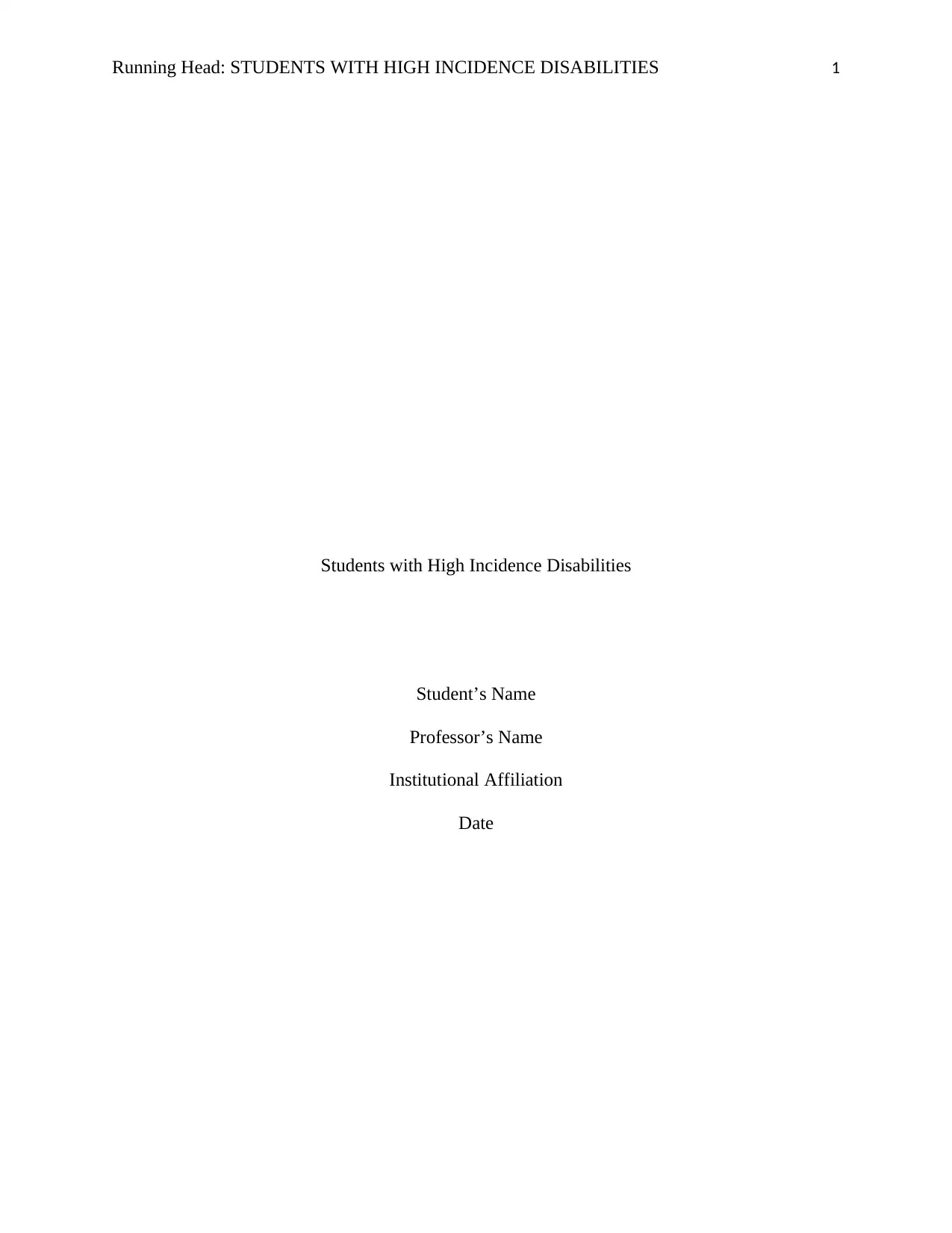
Running Head: STUDENTS WITH HIGH INCIDENCE DISABILITIES 1
Students with High Incidence Disabilities
Student’s Name
Professor’s Name
Institutional Affiliation
Date
Students with High Incidence Disabilities
Student’s Name
Professor’s Name
Institutional Affiliation
Date
Paraphrase This Document
Need a fresh take? Get an instant paraphrase of this document with our AI Paraphraser
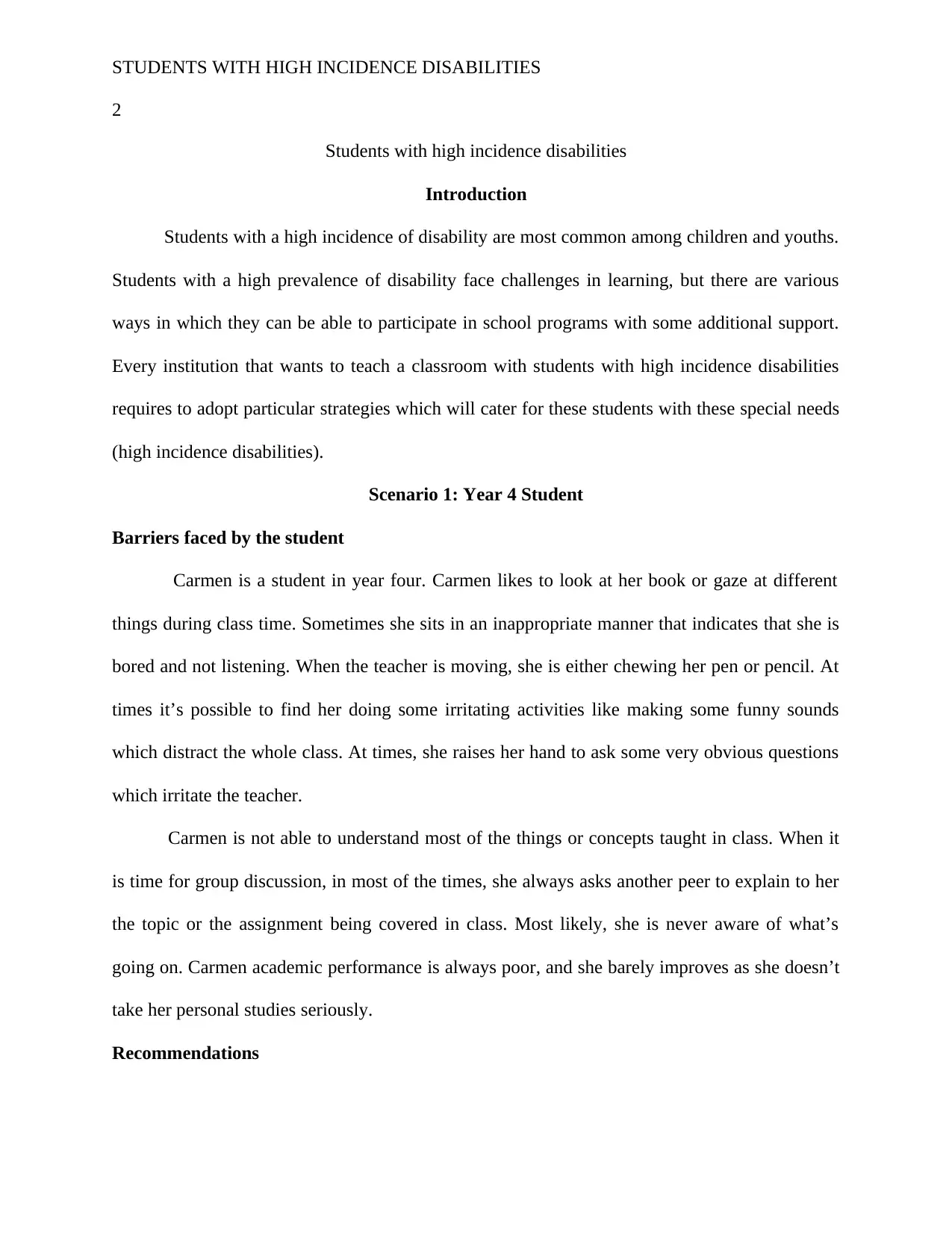
STUDENTS WITH HIGH INCIDENCE DISABILITIES
2
Students with high incidence disabilities
Introduction
Students with a high incidence of disability are most common among children and youths.
Students with a high prevalence of disability face challenges in learning, but there are various
ways in which they can be able to participate in school programs with some additional support.
Every institution that wants to teach a classroom with students with high incidence disabilities
requires to adopt particular strategies which will cater for these students with these special needs
(high incidence disabilities).
Scenario 1: Year 4 Student
Barriers faced by the student
Carmen is a student in year four. Carmen likes to look at her book or gaze at different
things during class time. Sometimes she sits in an inappropriate manner that indicates that she is
bored and not listening. When the teacher is moving, she is either chewing her pen or pencil. At
times it’s possible to find her doing some irritating activities like making some funny sounds
which distract the whole class. At times, she raises her hand to ask some very obvious questions
which irritate the teacher.
Carmen is not able to understand most of the things or concepts taught in class. When it
is time for group discussion, in most of the times, she always asks another peer to explain to her
the topic or the assignment being covered in class. Most likely, she is never aware of what’s
going on. Carmen academic performance is always poor, and she barely improves as she doesn’t
take her personal studies seriously.
Recommendations
2
Students with high incidence disabilities
Introduction
Students with a high incidence of disability are most common among children and youths.
Students with a high prevalence of disability face challenges in learning, but there are various
ways in which they can be able to participate in school programs with some additional support.
Every institution that wants to teach a classroom with students with high incidence disabilities
requires to adopt particular strategies which will cater for these students with these special needs
(high incidence disabilities).
Scenario 1: Year 4 Student
Barriers faced by the student
Carmen is a student in year four. Carmen likes to look at her book or gaze at different
things during class time. Sometimes she sits in an inappropriate manner that indicates that she is
bored and not listening. When the teacher is moving, she is either chewing her pen or pencil. At
times it’s possible to find her doing some irritating activities like making some funny sounds
which distract the whole class. At times, she raises her hand to ask some very obvious questions
which irritate the teacher.
Carmen is not able to understand most of the things or concepts taught in class. When it
is time for group discussion, in most of the times, she always asks another peer to explain to her
the topic or the assignment being covered in class. Most likely, she is never aware of what’s
going on. Carmen academic performance is always poor, and she barely improves as she doesn’t
take her personal studies seriously.
Recommendations
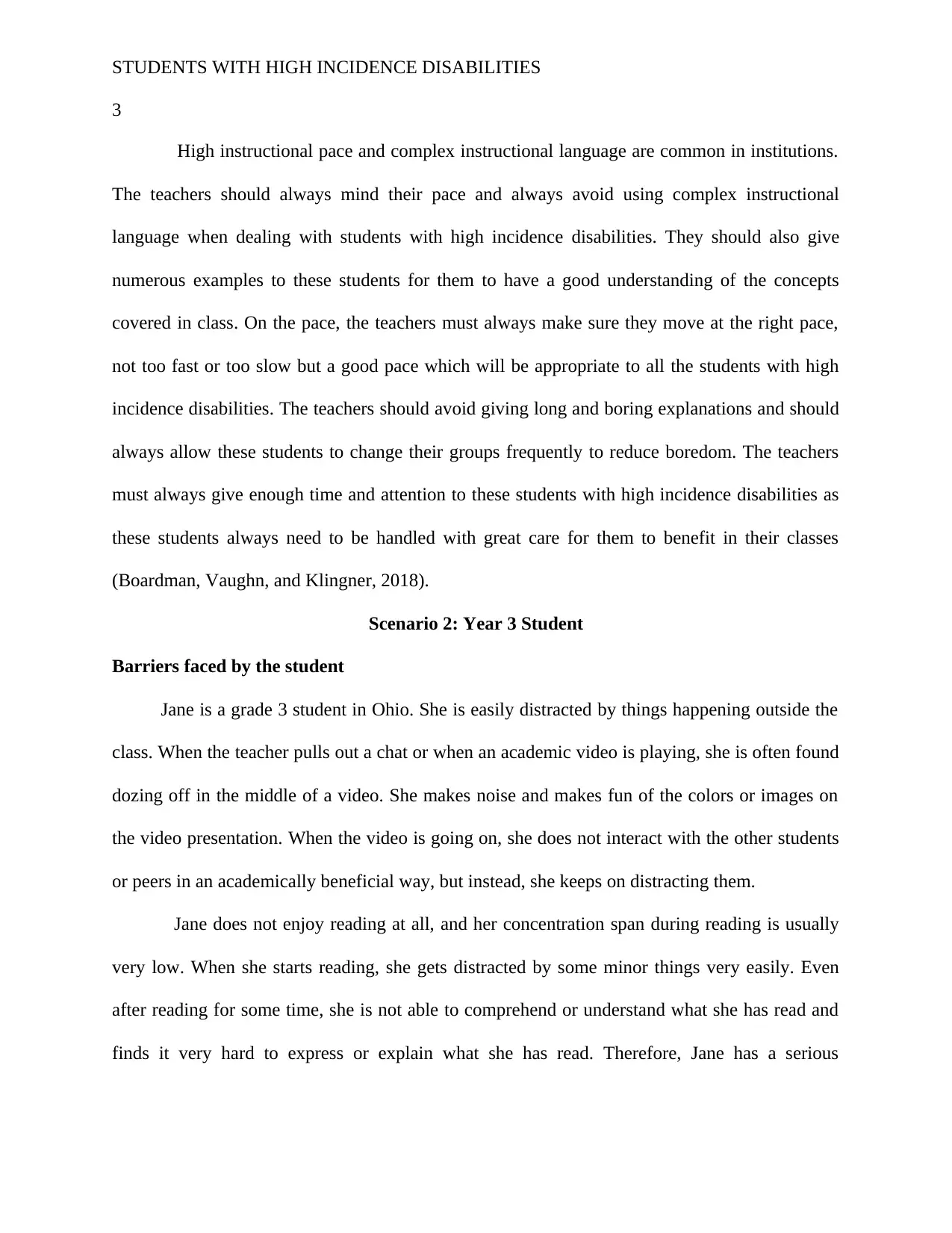
STUDENTS WITH HIGH INCIDENCE DISABILITIES
3
High instructional pace and complex instructional language are common in institutions.
The teachers should always mind their pace and always avoid using complex instructional
language when dealing with students with high incidence disabilities. They should also give
numerous examples to these students for them to have a good understanding of the concepts
covered in class. On the pace, the teachers must always make sure they move at the right pace,
not too fast or too slow but a good pace which will be appropriate to all the students with high
incidence disabilities. The teachers should avoid giving long and boring explanations and should
always allow these students to change their groups frequently to reduce boredom. The teachers
must always give enough time and attention to these students with high incidence disabilities as
these students always need to be handled with great care for them to benefit in their classes
(Boardman, Vaughn, and Klingner, 2018).
Scenario 2: Year 3 Student
Barriers faced by the student
Jane is a grade 3 student in Ohio. She is easily distracted by things happening outside the
class. When the teacher pulls out a chat or when an academic video is playing, she is often found
dozing off in the middle of a video. She makes noise and makes fun of the colors or images on
the video presentation. When the video is going on, she does not interact with the other students
or peers in an academically beneficial way, but instead, she keeps on distracting them.
Jane does not enjoy reading at all, and her concentration span during reading is usually
very low. When she starts reading, she gets distracted by some minor things very easily. Even
after reading for some time, she is not able to comprehend or understand what she has read and
finds it very hard to express or explain what she has read. Therefore, Jane has a serious
3
High instructional pace and complex instructional language are common in institutions.
The teachers should always mind their pace and always avoid using complex instructional
language when dealing with students with high incidence disabilities. They should also give
numerous examples to these students for them to have a good understanding of the concepts
covered in class. On the pace, the teachers must always make sure they move at the right pace,
not too fast or too slow but a good pace which will be appropriate to all the students with high
incidence disabilities. The teachers should avoid giving long and boring explanations and should
always allow these students to change their groups frequently to reduce boredom. The teachers
must always give enough time and attention to these students with high incidence disabilities as
these students always need to be handled with great care for them to benefit in their classes
(Boardman, Vaughn, and Klingner, 2018).
Scenario 2: Year 3 Student
Barriers faced by the student
Jane is a grade 3 student in Ohio. She is easily distracted by things happening outside the
class. When the teacher pulls out a chat or when an academic video is playing, she is often found
dozing off in the middle of a video. She makes noise and makes fun of the colors or images on
the video presentation. When the video is going on, she does not interact with the other students
or peers in an academically beneficial way, but instead, she keeps on distracting them.
Jane does not enjoy reading at all, and her concentration span during reading is usually
very low. When she starts reading, she gets distracted by some minor things very easily. Even
after reading for some time, she is not able to comprehend or understand what she has read and
finds it very hard to express or explain what she has read. Therefore, Jane has a serious
⊘ This is a preview!⊘
Do you want full access?
Subscribe today to unlock all pages.

Trusted by 1+ million students worldwide
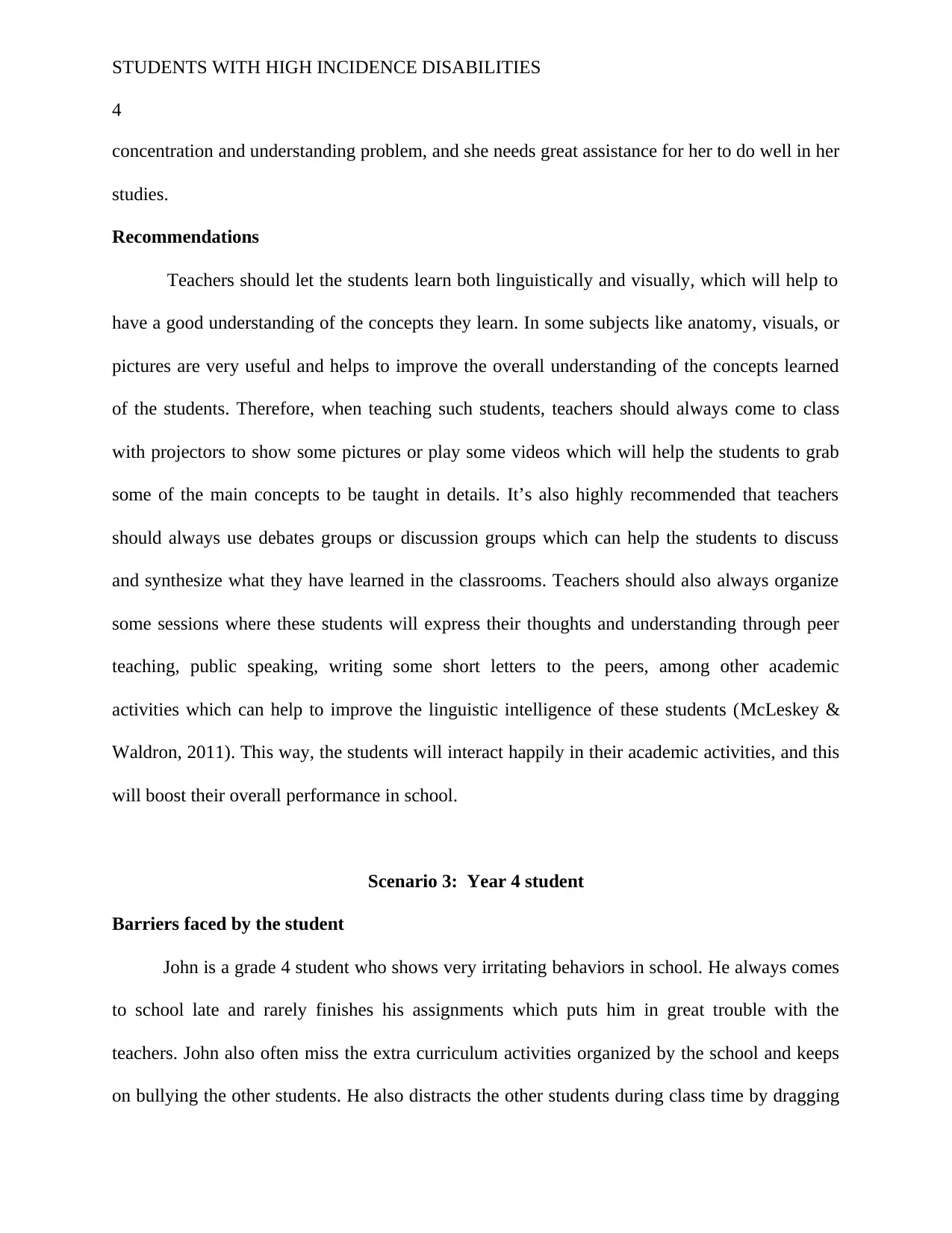
STUDENTS WITH HIGH INCIDENCE DISABILITIES
4
concentration and understanding problem, and she needs great assistance for her to do well in her
studies.
Recommendations
Teachers should let the students learn both linguistically and visually, which will help to
have a good understanding of the concepts they learn. In some subjects like anatomy, visuals, or
pictures are very useful and helps to improve the overall understanding of the concepts learned
of the students. Therefore, when teaching such students, teachers should always come to class
with projectors to show some pictures or play some videos which will help the students to grab
some of the main concepts to be taught in details. It’s also highly recommended that teachers
should always use debates groups or discussion groups which can help the students to discuss
and synthesize what they have learned in the classrooms. Teachers should also always organize
some sessions where these students will express their thoughts and understanding through peer
teaching, public speaking, writing some short letters to the peers, among other academic
activities which can help to improve the linguistic intelligence of these students (McLeskey &
Waldron, 2011). This way, the students will interact happily in their academic activities, and this
will boost their overall performance in school.
Scenario 3: Year 4 student
Barriers faced by the student
John is a grade 4 student who shows very irritating behaviors in school. He always comes
to school late and rarely finishes his assignments which puts him in great trouble with the
teachers. John also often miss the extra curriculum activities organized by the school and keeps
on bullying the other students. He also distracts the other students during class time by dragging
4
concentration and understanding problem, and she needs great assistance for her to do well in her
studies.
Recommendations
Teachers should let the students learn both linguistically and visually, which will help to
have a good understanding of the concepts they learn. In some subjects like anatomy, visuals, or
pictures are very useful and helps to improve the overall understanding of the concepts learned
of the students. Therefore, when teaching such students, teachers should always come to class
with projectors to show some pictures or play some videos which will help the students to grab
some of the main concepts to be taught in details. It’s also highly recommended that teachers
should always use debates groups or discussion groups which can help the students to discuss
and synthesize what they have learned in the classrooms. Teachers should also always organize
some sessions where these students will express their thoughts and understanding through peer
teaching, public speaking, writing some short letters to the peers, among other academic
activities which can help to improve the linguistic intelligence of these students (McLeskey &
Waldron, 2011). This way, the students will interact happily in their academic activities, and this
will boost their overall performance in school.
Scenario 3: Year 4 student
Barriers faced by the student
John is a grade 4 student who shows very irritating behaviors in school. He always comes
to school late and rarely finishes his assignments which puts him in great trouble with the
teachers. John also often miss the extra curriculum activities organized by the school and keeps
on bullying the other students. He also distracts the other students during class time by dragging
Paraphrase This Document
Need a fresh take? Get an instant paraphrase of this document with our AI Paraphraser
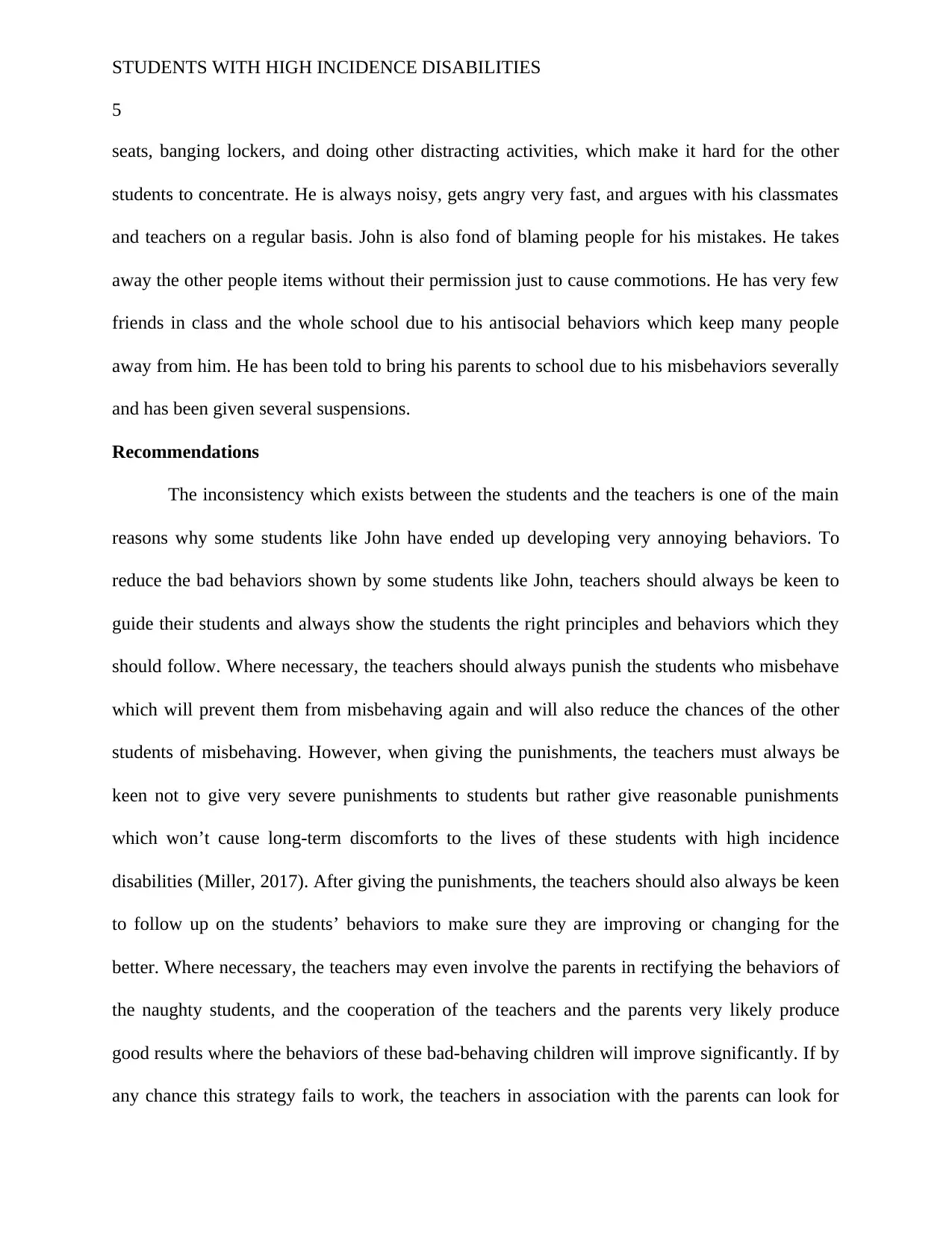
STUDENTS WITH HIGH INCIDENCE DISABILITIES
5
seats, banging lockers, and doing other distracting activities, which make it hard for the other
students to concentrate. He is always noisy, gets angry very fast, and argues with his classmates
and teachers on a regular basis. John is also fond of blaming people for his mistakes. He takes
away the other people items without their permission just to cause commotions. He has very few
friends in class and the whole school due to his antisocial behaviors which keep many people
away from him. He has been told to bring his parents to school due to his misbehaviors severally
and has been given several suspensions.
Recommendations
The inconsistency which exists between the students and the teachers is one of the main
reasons why some students like John have ended up developing very annoying behaviors. To
reduce the bad behaviors shown by some students like John, teachers should always be keen to
guide their students and always show the students the right principles and behaviors which they
should follow. Where necessary, the teachers should always punish the students who misbehave
which will prevent them from misbehaving again and will also reduce the chances of the other
students of misbehaving. However, when giving the punishments, the teachers must always be
keen not to give very severe punishments to students but rather give reasonable punishments
which won’t cause long-term discomforts to the lives of these students with high incidence
disabilities (Miller, 2017). After giving the punishments, the teachers should also always be keen
to follow up on the students’ behaviors to make sure they are improving or changing for the
better. Where necessary, the teachers may even involve the parents in rectifying the behaviors of
the naughty students, and the cooperation of the teachers and the parents very likely produce
good results where the behaviors of these bad-behaving children will improve significantly. If by
any chance this strategy fails to work, the teachers in association with the parents can look for
5
seats, banging lockers, and doing other distracting activities, which make it hard for the other
students to concentrate. He is always noisy, gets angry very fast, and argues with his classmates
and teachers on a regular basis. John is also fond of blaming people for his mistakes. He takes
away the other people items without their permission just to cause commotions. He has very few
friends in class and the whole school due to his antisocial behaviors which keep many people
away from him. He has been told to bring his parents to school due to his misbehaviors severally
and has been given several suspensions.
Recommendations
The inconsistency which exists between the students and the teachers is one of the main
reasons why some students like John have ended up developing very annoying behaviors. To
reduce the bad behaviors shown by some students like John, teachers should always be keen to
guide their students and always show the students the right principles and behaviors which they
should follow. Where necessary, the teachers should always punish the students who misbehave
which will prevent them from misbehaving again and will also reduce the chances of the other
students of misbehaving. However, when giving the punishments, the teachers must always be
keen not to give very severe punishments to students but rather give reasonable punishments
which won’t cause long-term discomforts to the lives of these students with high incidence
disabilities (Miller, 2017). After giving the punishments, the teachers should also always be keen
to follow up on the students’ behaviors to make sure they are improving or changing for the
better. Where necessary, the teachers may even involve the parents in rectifying the behaviors of
the naughty students, and the cooperation of the teachers and the parents very likely produce
good results where the behaviors of these bad-behaving children will improve significantly. If by
any chance this strategy fails to work, the teachers in association with the parents can look for
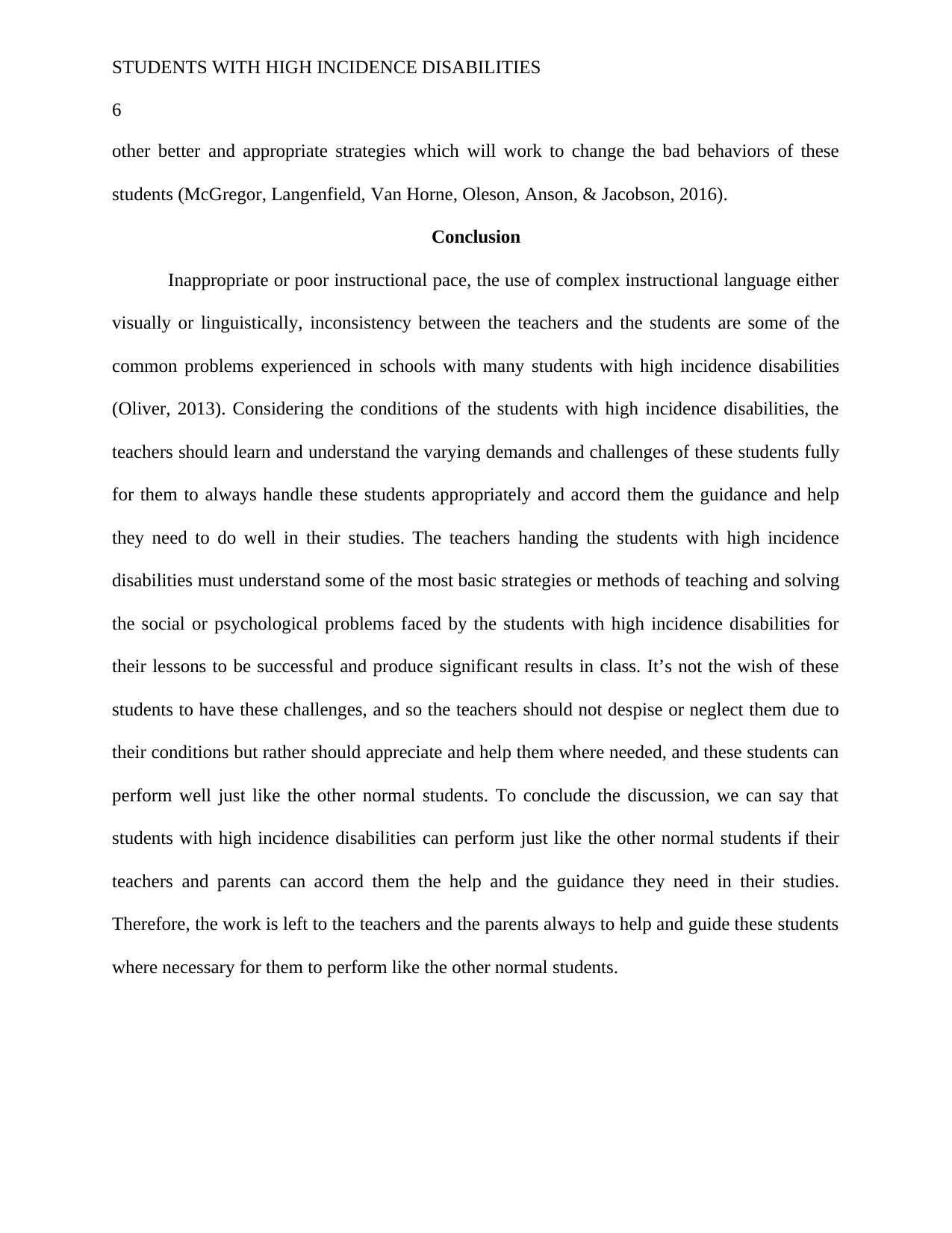
STUDENTS WITH HIGH INCIDENCE DISABILITIES
6
other better and appropriate strategies which will work to change the bad behaviors of these
students (McGregor, Langenfield, Van Horne, Oleson, Anson, & Jacobson, 2016).
Conclusion
Inappropriate or poor instructional pace, the use of complex instructional language either
visually or linguistically, inconsistency between the teachers and the students are some of the
common problems experienced in schools with many students with high incidence disabilities
(Oliver, 2013). Considering the conditions of the students with high incidence disabilities, the
teachers should learn and understand the varying demands and challenges of these students fully
for them to always handle these students appropriately and accord them the guidance and help
they need to do well in their studies. The teachers handing the students with high incidence
disabilities must understand some of the most basic strategies or methods of teaching and solving
the social or psychological problems faced by the students with high incidence disabilities for
their lessons to be successful and produce significant results in class. It’s not the wish of these
students to have these challenges, and so the teachers should not despise or neglect them due to
their conditions but rather should appreciate and help them where needed, and these students can
perform well just like the other normal students. To conclude the discussion, we can say that
students with high incidence disabilities can perform just like the other normal students if their
teachers and parents can accord them the help and the guidance they need in their studies.
Therefore, the work is left to the teachers and the parents always to help and guide these students
where necessary for them to perform like the other normal students.
6
other better and appropriate strategies which will work to change the bad behaviors of these
students (McGregor, Langenfield, Van Horne, Oleson, Anson, & Jacobson, 2016).
Conclusion
Inappropriate or poor instructional pace, the use of complex instructional language either
visually or linguistically, inconsistency between the teachers and the students are some of the
common problems experienced in schools with many students with high incidence disabilities
(Oliver, 2013). Considering the conditions of the students with high incidence disabilities, the
teachers should learn and understand the varying demands and challenges of these students fully
for them to always handle these students appropriately and accord them the guidance and help
they need to do well in their studies. The teachers handing the students with high incidence
disabilities must understand some of the most basic strategies or methods of teaching and solving
the social or psychological problems faced by the students with high incidence disabilities for
their lessons to be successful and produce significant results in class. It’s not the wish of these
students to have these challenges, and so the teachers should not despise or neglect them due to
their conditions but rather should appreciate and help them where needed, and these students can
perform well just like the other normal students. To conclude the discussion, we can say that
students with high incidence disabilities can perform just like the other normal students if their
teachers and parents can accord them the help and the guidance they need in their studies.
Therefore, the work is left to the teachers and the parents always to help and guide these students
where necessary for them to perform like the other normal students.
⊘ This is a preview!⊘
Do you want full access?
Subscribe today to unlock all pages.

Trusted by 1+ million students worldwide
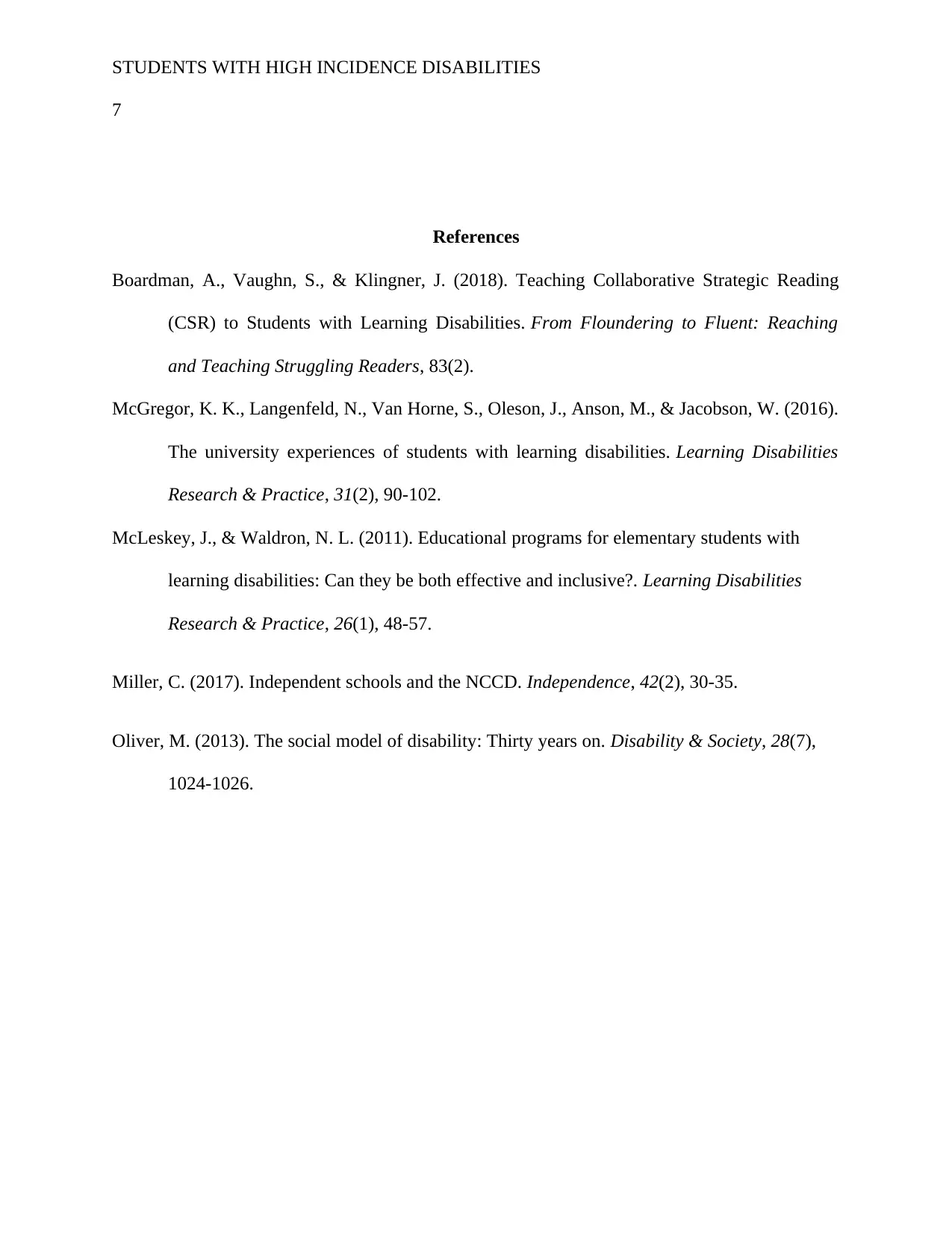
STUDENTS WITH HIGH INCIDENCE DISABILITIES
7
References
Boardman, A., Vaughn, S., & Klingner, J. (2018). Teaching Collaborative Strategic Reading
(CSR) to Students with Learning Disabilities. From Floundering to Fluent: Reaching
and Teaching Struggling Readers, 83(2).
McGregor, K. K., Langenfeld, N., Van Horne, S., Oleson, J., Anson, M., & Jacobson, W. (2016).
The university experiences of students with learning disabilities. Learning Disabilities
Research & Practice, 31(2), 90-102.
McLeskey, J., & Waldron, N. L. (2011). Educational programs for elementary students with
learning disabilities: Can they be both effective and inclusive?. Learning Disabilities
Research & Practice, 26(1), 48-57.
Miller, C. (2017). Independent schools and the NCCD. Independence, 42(2), 30-35.
Oliver, M. (2013). The social model of disability: Thirty years on. Disability & Society, 28(7),
1024-1026.
7
References
Boardman, A., Vaughn, S., & Klingner, J. (2018). Teaching Collaborative Strategic Reading
(CSR) to Students with Learning Disabilities. From Floundering to Fluent: Reaching
and Teaching Struggling Readers, 83(2).
McGregor, K. K., Langenfeld, N., Van Horne, S., Oleson, J., Anson, M., & Jacobson, W. (2016).
The university experiences of students with learning disabilities. Learning Disabilities
Research & Practice, 31(2), 90-102.
McLeskey, J., & Waldron, N. L. (2011). Educational programs for elementary students with
learning disabilities: Can they be both effective and inclusive?. Learning Disabilities
Research & Practice, 26(1), 48-57.
Miller, C. (2017). Independent schools and the NCCD. Independence, 42(2), 30-35.
Oliver, M. (2013). The social model of disability: Thirty years on. Disability & Society, 28(7),
1024-1026.
1 out of 7
Related Documents
Your All-in-One AI-Powered Toolkit for Academic Success.
+13062052269
info@desklib.com
Available 24*7 on WhatsApp / Email
![[object Object]](/_next/static/media/star-bottom.7253800d.svg)
Unlock your academic potential
Copyright © 2020–2025 A2Z Services. All Rights Reserved. Developed and managed by ZUCOL.




